- Submissions

Full Text
Archaeology & Anthropology: Open Access
Geo-Diversity and Geo-Heritage Site Selection in Beach Ridge and Islands in the Eastern Coast of Southern India
Antony Ravindran A1, Mondal NC2, Ramanujam N3, Sudarsan R4 and Suresh Baboon DS5
1Deptartment of Geology, VO Chidambaram College, Manonmaniam Sunaranar University, India
2Earth Process Modleing Group, CSIR-National Geophysical Research Institute, India
3Department of Coastal Disaster Management, Pondicherry Central University, Andaman
4Department of Programming, IGNOU, India
5National Centre for Earth Science Studies, Ministry of Earth Sciences, Govt. of India, India
*Corresponding author: A. Antony Ravindran, Department of Geology, V.O. Chidambaram College, Manonmaniam Sunaranar University, Thoothukudi, India
Submission: September 23, 2017;Published: April 17, 2018

ISSN: 2577-1949Volume1 Issue5
Abstract
This article deals with the significant geological, geo-scientific studies and geo-heritage site selection along with the Gulf of Manner of Eastern Coast in Southern India. The study area geologically formed in quaternary deposits of soil and recent tectonically formed coastal landforms. The entire area of the Gulf of Mannar coast landform exists a geomorphology of the cave, dunes, wave cliffs, erosional features etc. It is around 456 km from Kanyakumari to Dhanushkodi along the coast of the Gulf of Mannar. The valuable geological sites of Kanyakumari, Vattakottai, Idinthakarai, Chokkan Kudiirupu Teri deposits, Manapadu Sandridge, St. Xavier Cave, Tiruchendur Valli cave, Rameshwaram Raman Temple, Dhanushkodi old heritage places are essential features. About 21 islands have been formed due to the flow of various river channels in four groups of the Gulf of Mannar Islands.
The different structures of mudflat, pot holes, shell, and quaternary recent fossil deposits of sedimentary deposits are being accumulated in and around the natural beach. The valuable beach has substantial mineral deposits of garnet, rutile, zircon, and monazite. The migration of beach dune is due to the sea wave and tidal impact, and it is generated new structures like cliffs and cave in the study area. Geo-diversity geographical heritage and parks are mainly located in this coast. The geological features like rocks, minerals, fossil, soil, different geological units, landscapes and history of earth evolution are called as diversity. These are the importance of the archaeological and ecological studies. Along with this, the study is also used for identification of suitable sites such as Van and Nallathanni Islands, which are found very good in-term of groundwater quality to visit as geo-tourism and geo-heritage place in the Gulf of Mannar Islands.
Keywords: Geo-heritage; Tourism sites; Islands; Gulf of Mannar; Southern India
Introduction
Geo-tourism is defined as tourism that sustains or enhances the geographical character of a place like its environment, culture, aesthetics, heritage, and the well-being of its residents. It incorporates the concept of sustainable tourist spots, which should remain unspoiled for future generations while allowing for ways to protect a place’s character. Geo-tourism also takes a principle from its ecotourism cousin that tourism revenue should promote conservation and extends it to culture and history as well that is, all distinctive assets of a place. Its site selection depends upon the geomorphology and uses for the study to geo-scientific students involving conservation education and Geo-tourism [1-7]. This study is based on the geological study of heritage sites in the coast of South India. It covered a tourist site in the seaside of Southern India and also 21 islands formed in the very close to the shoreline (Figure 1).
It is covered mainly in between Kanyakumari to Dhanushkodi in the Southern part of India [8-10]. The Gulf of Mannar shallow was a sediment depocenter in confined depositional setting till Late Cretaceous receiving clastic sediment input both from basin margin towards the west and Mandapam-Delft ridge towards to the east. Unconfined setting emerged post-Cretaceous shifted depocenter to east of Mandapam-Delft ridge [11]. The Achaean Kovil shear zone is an active zone near Kanniyakumari to Manapad area. The coastal marine tectonic activity and its impact reflect some tourism site in the Gulf of Mannar coast.
Two earthquake events have been recorded in the south of the shore area in the recent past. The first record belongs to the year 1938. Its epicentre was at Latitude: 07.50 N and Longitude: 79.00 E [12]. Its magnitude is questionable but is thought to be ~5.8. Its intensity has been recorded as VII. The second record is from 1993. Its epicentre was at Latitude: 06.810 N and Longitude: 78.300 E. Its depth (D) was identified to be 10.0km. Its Body Wave Magnitude (Mb) and Surface Wave Magnitude (Ms) were 5.2 and 4.7, respectively [12].
Figure 1: Eurozone VAT and corporate tax rates: 1996-2016.
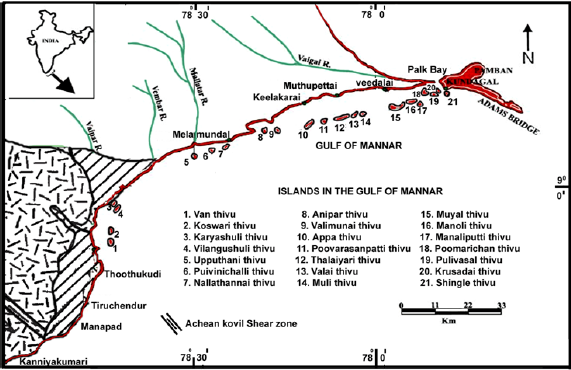
There is a record that an earthquake which originated at the Car Nicobar islands on 31st December 1881 (with a Mw 7.9) had generated a tsunami in the Bay of Bengal [13] and this had been felt at different points on the eastern coast of Southern India and also at Pamban. This fact stresses the importance of studying the history of the earthquakes in an area roughly around 300 km around. The 26th June 1941 earthquake of Andaman Islands (12.500 N, 92.500 E) (Mw7.7) had also generated a tsunami, and this had reached Chennai. The first recorded Bay of Bengal earthquake is on 28th January 1679. It is suspected to have originated in the Andaman Islands. The more recent Pondicherry earthquake of 26th September 2001 had its epicentre in the ocean crust (11.940 N, 80.220 E, Mw 5.4).
Apart from this, the catastrophic waves generated by the tsunami on 26th December, 2004 in the Indian Ocean devastated the Tamil Nadu, parts of Andhra Pradesh and Kerala coasts. Houses built along the seaside, coastal landforms and beaches were heavily damaged by resilient tsunami inundation. The tsunami waves alter severely the mouth and estuary regions. They enter inland from the SSE direction in the study area as diffracted waves. The tsunami wave heights varied from 2.0 to 10.0m and the inundation into the main land was ranged from 0.2 to 2.0km [14,15].
The tsunami waves alter the sediment dynamics when reached to the beaches, thus altering the coastal geomorphology by breaching dunes, eroding beaches to form new channels, filling of estuaries and backwater channels by sediments. The investigation has given an idea about the sediment logical evidence preserved between Rameswaram (north) and Tuticorin (south). The effect of tsunami waves was more along the projected and flat beaches. The shallow shelf beaches were not affected by the tsunami waves. But the Gulf of Mannar coast was exaggerated by the diffracted tsunami waves from the southern Sri Lankan coast. Tsunami inundation along the southern Mannar coast is moderate. Tsunami impact along the northern Gulf of Mannar coast between Dhanushkodi and Thoothukudi is comparatively less due to the presence of 21 coral islands. The coast considered as raised coast consisting of coralline terraces.
Various marine landform features such as beaches, bay, sport, beach ridges, backwater zone, offshore islands, coral reefs, and wave-cut platform, sea cliff, marginal terrace, headlands, salient’s, and tom bolos have identified in the shoreline. The area along Indian Southeast Coast that stretches from Kanyakumari to Dhanushkodi (~440 km) forms part of the Gulf of Mannar in the Southern India. Twenty-one islands of four island groups selected for windgenerated waves are primarily responsible for erosion, near shore currents and sand transport pattern. The coastal erosion due to the wave energy obtained from the storm winds during monsoon periods is thereby efficiently carried to the near shore zone, where it expands over a relatively narrow area in the study area. The occurrence of rocks such as sandstone, calcareous shell limestone, gneiss rock, and charnockite considers for illustration of the site section.
Geo-Diversity In the Coastal Area
Geo-heritage site identification in the coastal area and its geodiversity are vital for the selection of Indian heritage sites. They are the Manapadead Portuguese fort, Notch and cave of the cliff section, Wave erosion topples the cliff rock, Toe erosion formed a notch, Ship Matha Temple in Ovari beach, and 1942 Ovari Church in the study area (Figure 2a-2f). The buried Church near Chokankudierupu (Figure 3a); Tiruchendur beach, Tiruchendur beach-after the Tsunami 2004, Valli cave since 1942, Valli cave in 2014 (Figures 4a-4d), Valli cave way, Historical value place of a cave; Idinthakari beach cliffs and cave formation, and Vattakottai Illeminite beach (Figure 5), Vattakottai fort Wall, Duch port (Historical place), and Historical water tank; Kannya kumari Beach and Thiruvallu Valluvar statue (Figure 6); Rameshwaram Island and Sand dune in Rameshwaram (Figure 7); and Dhanushkodi 1980 down ship, and Dhanushkodi post office are also the famous of them.
Figure 2: Showing (a) Manapadead Portuguese fort, (b) Notch and cave of the cliff section, (c) Wave erosion topple the cliff rock, (d) Toe erosion formed notch, (e) Ship Matha Temple in Ovari beach, and (f) 1942 Ovari Church in the study area.
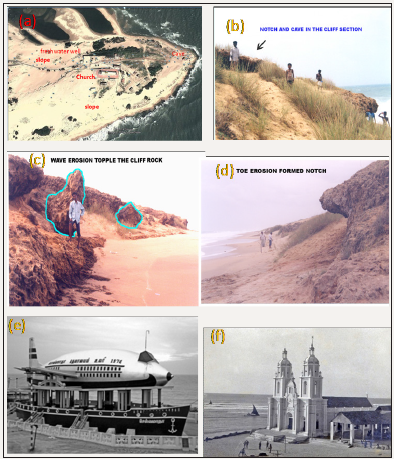
Figure 3: Showing (a) Buried Church near Chokankudierupu and (b) Cyclonic effect and red soil covered high in the study area.
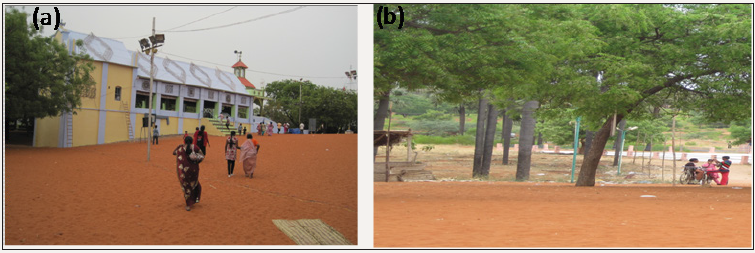
Figure 4: Showing (a) Tiruchendur beach (b) Tiruchendur beach-after the Tsunami 2004 (c) Valli cave since 1942 (d) Valli cave in 2014 in the study area.
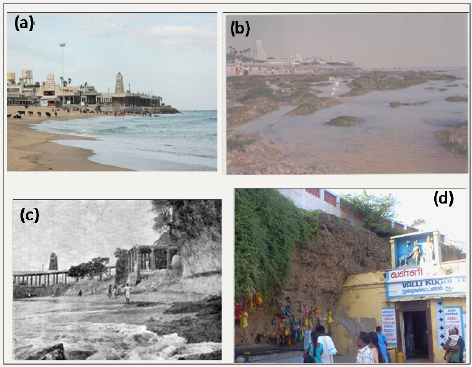
Figure 5: Showing Vattakottai Illeminite beach in the study area.
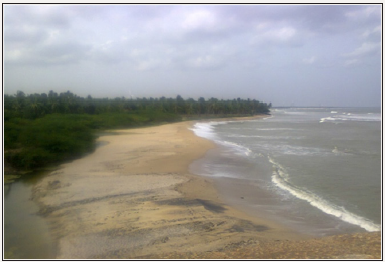
Figure 6: Kanyakumari Beach, Thiruvallu Valluvar statue and highly weathered charnockite rock in the study area.
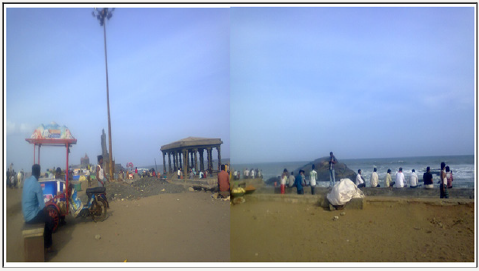
Figure 7: Showing (a) The Rameshwaram Island (b) Sand dune in Rameshwaram.
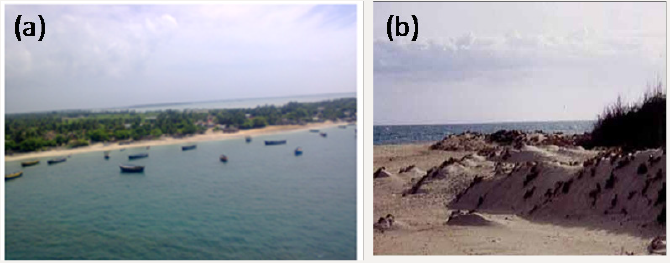
Figure 8: Showing (a) The Rameshwaram Island (b) Sand dune in Rameshwaram.
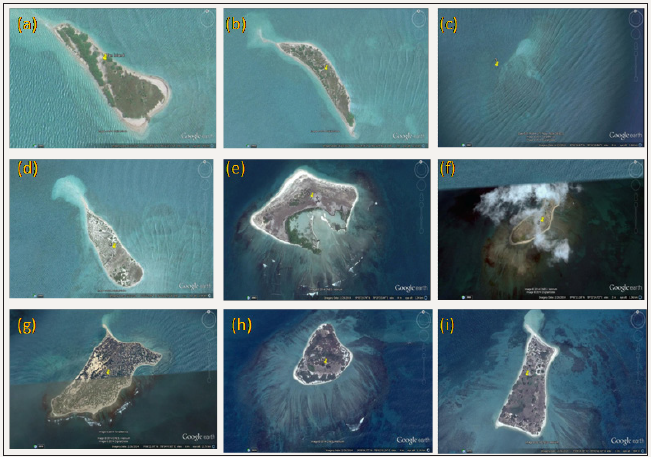
Twenty-one islands (Figures 8 & 9) mainly located on the eastern coast of Sothern India. They are Van, Koswari, Villangusulli, Kariyasulli, Upputhani, Pulluvinchali, Nallathanni, Anipar, Vallimunai, Appa, Poovarasapatti, Thalayari, Muyal, Manoli, Valli, Mulli, Mannalipatthi, Poomarichan, Pulivasal, Kurusadi, and Shingle Islands (Thivu). These Islands are suitable for the tourism and also studying for geo-diversity and Indian geo-heritage.
The geo-diversity of the selected site is the main problem of soil and cliff erosion. It was also affected by the cyclones and littoral disasters. The entire study area was influenced by the coastal tectonic activity. The continental and oceanic plate junction occurs in the margin of the beach terrace. Tectonically and geologically this seaside elevated terrace acts as a barrier to prevent saline water intrusion. Therefore, freshwater and saline water are not mixing easily in the shallow aquifer due to the density variations. Thus freshwater is accumulated in shallow aquifer wells of all heritage sites (i.e., Nalli Kinaru). The main study revealed that the beach cliff and dune are simply eroded due to the wave action. The study area is broadly classified into the rocky coast and sandy beaches.
Figure 9: Showing (j) Appa Thivu (k) Poovarasapatti Thivu (l) Thalayari Thivu (m) Muyal Thivu (n) Manoli Thivu (o) Valli Thivu (p) Mulli Thivu (q) Mannalipatthi Thivu (r) Poomarichan Thivu, (s) Pulivasal Thivu (t) Kurusadi Island (u) Shingle Island.

Figure 10: Individual island/thivu distances from the shoreline in the study area.
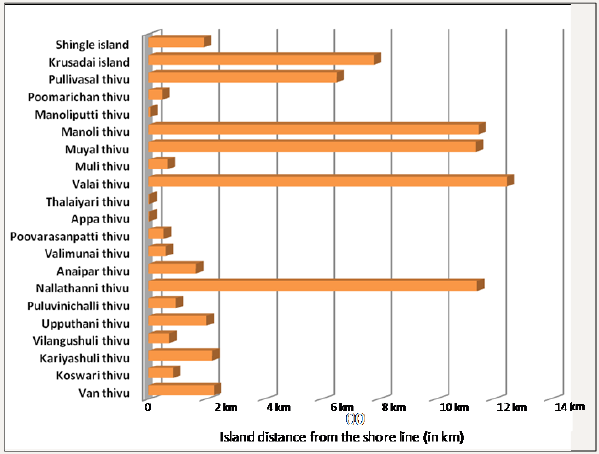
Methodology
Geological importance beach ridge and suitable islands are imperative to identify for geo-heritage site selection and geo-parks in Southern India. It depends upon 5 factors like
- Suitable for a geo-scientific study where student and researcher can visit for their topographical survey and field investigation.
- Tectonically active zone to create new features recently.
- Identification of geological and favourable visiting place for Geo-tourism.
- Focus the environmental pollution and human activity in the selected site.
- Economically suitable for the site selection.
Engineering and environmental problems arise with social and economic developments in these areas. Seawater intrusion, beach stability, beach dewatering for industrial use and deterioration of the marine environment are the engineering and hydro geological problems, which are hindering the social and economic development along the seaside. A beach groundwater table could also influence the limiting factor for agricultural activities in the adjoining coastal areas in the form of seawater intrusion. Lithified rocks on the coast comprise of cliff, platforms, and reefs. Many coasts with cliffs have a primary tectonic control through jointing and faulting [16]. Several authors have described such platform morphology [17,18]. Morphological features of the beaches are created by wave actions directly or indirectly and ultimately induce the sediment transport and beach changes. These morphological features define about berms and bars of beach profiles. Field data to study the morph dynamic state of the beaches were collected during various seasons [19]. The morphological changes in this area of the depositional environment of sediment transport along with rivers and landform developed though wave action indirectly.
Geo-Heritage Sites Selection
Coastal geomorphology concerns the formation of landforms, influenced by atmospheric, oceanographic, geologic and hydrologic processes, etc. Morph dynamic state of beach incorporates all the processes mentioned above which are continuously working to achieve a state of equilibrium. The constant changes of driving forces on the beach morphology in the seaside area are adjusted in a new hydrodynamic regime which often prevents the equilibrium from its initial state achieved. Positive feedback mechanisms amplify instabilities in the system and result in self-forcing behavior such as beach erosion, beach accretion, the formation of salient and tumble, the formation of beach cusps, etc.
There are seasonal changes in the geomorphology of the study area, and these changes are highly related to the southwest and northeast monsoons. The wetlands are one of the important marine landforms observed in the study area. Morphological changes are due to the depositional environment of sediment transport along with rivers and landform development of wave action. Beaches developed extensively along the entire coast of the Gulf of Mannar except in some places. The beaches between Kanyakumari to Dhanushkodi and Gulf of Mannar Islands surveyed in the Gulf of Mannar coast (Figure 1). The beaches in these areas are gently sloping and formed by the plunge point due to wave action. Shoreline salients are low triangular landforms, which project seaward as promontories. The term “tombolo” is applied when this landform joins to an island or breaker. Islands refract incoming waves causing them to bend inward around the island and converge along the mainland in opposite directions. This process produces a net transport of sand in two directions towards the island, resulting in a spit of sand that grows outward from the shore. Prominent features present in the study area are dunes, backshore width, wave cut features and potholes, bays, spit, backwater zone, mudflat, and back swamp. Dunes are omnipresent in the coastal section of the southern sector. They occur as a series of dune ridges usually, not always parallel to each other. In the vicinity of Tiruchendur area, dune height varies from 1.6 to 2.0m, whereas in the rest of the areas the dunes have a height < 1.0m. In the northern sector, few dunes are present at Valinockam, Mandapam and Rameswaram region.
Wave-cut features are visible at all the headlands. At Manapad Potholes with diameters of 60 to 160cm are seen in the near shore zones of the exposed rocks. The pseudo pebble-like features develop due to grinding action of waves. The grinding process by the pebbles due to waves results in pot whole formation. In the southern sector, a well-developed bay exists between Manapad headland and Tiruchendur headland. There is a small bay formation in the north of Tiruchendur headland. The shape of this bay is dynamic; more erosion is encountered during monsoon periods. In the northern sector, the bay formations are observed at Vepoladai and Vallinokam.
The Manapad headland and its special features are occurring near fossil, lithified calcareous sandstone with shell, cave, bay, cliff, dunes, and erosion. The freshwater Submarine Ground Water Discharge (SGWD) study near dune site is easily explained [20]. Rainfall, runoff, and infiltration of water in the hydrological cycle makes towards the leeward side of the dunes. The freshwater and saline water mixing zone is not mixed due to the density variation of fresh and saline fluid properties. It is a useful site for Geotourism and Geo-student research about morphological changes of the beach, wave classification, and tidal impact and dune studies. The Idinthakarai area is famous for the border erosion of dune area. The erosion is occurring due to the weathering of rock properties and wave climatic changes.
Vattakotai is a famous port for Dutch people. In this area, most of the rocks enrich with monazite beach sediments. The Ovari dune site is a major problem of erosion. In this site, the famous St. Antony Church is found in the near beach area. After the recent tsunami entire geomorphology is completely changed due to the weathering of the submarine plate and dune transgressions. The beach width is around is 5m. Manapad completely forms by high strength of calcareous shell sandstone. The cliff erosion and high wave activity generate cave on the site. The two well accumulated in the depth of below 5m below ground level (bgl) to identify the coastal aquifer condition of the study area. The sunrise is a famous one for Indian heritage site; it occupies completely by Archean rock types weathered connect and massive charnockite rocks. This is an important tourist spot for Indian people.
Twenty-one islands are classified into four types such as 1) Tuticorin 2) Vembar 3) Keelakarai and 4) Mandapam groups of islands (Table 1) (Figure 8 & 9). The selection of suitable site depends upon the area of the island, and suitable heritage site for the tourists, such a quality of groundwater is good. It is having more amount of freshwater quantity in Nallathanni Thivu, and Van island of an area of 6670m2 is very close to the Thoothukudi city around 2.0 km distance in the sea (Figure 10). There are about 71% of Islands located within 2.0 km from the shoreline, but only 19% of islands like Manoli (6153m2), Muyal (6880m2) Valai (8106m2) and Nallathanni (2112m2) islands locate more than 10 km from the shoreline.
The estimated distance from the shoreline to the individual island uses for the site selection. It is possible to visit the island along with a boat. Some Islands are not to reach effortlessly because of more wave height. The specified island area of coverage includes the width and length of the island. It is used to determine the area including groundwater condition of the islands. For the different site selection, rock classification is observed, and it has been found mostly calcareous sandstone, leptynite rock, and charnockite. Manapad geological calcareous sandstone (229kg/ cm2), Idinthakarai leptinite rock (13.8 kg/cm2) and Kanyakumari charnockite rock (505kg/cm2) strengths are used to estimate the corrosive effect due to the seawater intrusion and wave induced force easily affect the coastal area. The retention depends upon the lithology, strength of cliff section, and beach dynamics on wave parameters.
Table 1: Gulf of Manner Groups of 21 Islands/ Thivu in the study area.

Conclusion
Geo-heritage site selection is an important one in and around the Gulf of Mannar in the eastern coast of Southern India. The area covers some recently developed geo-tectonic activity, as well as marine transgression and regression. It mainly covers with the beach sand ridges, caves and Submarine Groundwater Discharge (SGWD) wells. The sites located in the study area are popular for Geotourism such as Kanyakumari, Vattakottai, Rameshwaram, Ovary, and Chokkan Kudi Iruppu, etc. Among them, Manapad and Tiruchendur are more suitable heritage sites for geo-scientific studies such as cave formation, tsunami wave, tidal impacts and Submarine groundwater discharge studies. Four islands, among the 21 islands, are more suitable and economical travel inconvenient for Geotourism and Geoheritage sites. They are Van, Koswari, Nallathanni, and Valimunai islands. The Nallathanni Island (Freshwater Island) is especially suitable one for the heritage site. The site selection based on the different rock classifications like calcareous sandstone, leptynite, and charnockite is essential for the geo-tourism. The strength of Manapad geological calcareous sandstone (229kg/cm2), Idinthakarai leptinite rock (13.8kg/cm2) and Kanyakumari charnockite rock (505kg/cm2) is used to estimate the corrosive effect due to the seawater intrusion and wave induced force easily affect the coastal area. The rock retention depends upon the lithology and strength of cliff section, and beach dynamics on wave parameters. The above study is used to identify the suitable sites for geo-heritage and geo-diversity, and conservation of the coastal area along the Gulf of Mannar Coast in Southern India.
Acknowledgement
The authors are thankful to Prof. Alba Patrizia Santo, University of Florence (Italy), who has provided the constructive comments to improve the article.
References
- Ahluwalia AD (2006) Indian geo-heritage, geo-diversity: Geosites and geoparks. Current Science 91(10): 25.
- Pena dos Reis R, Helena Henriques M (2009) Approaching an integrated qualification and evaluation system for geological heritage. Geoheritage 1(1): 1-10.
- Alexandrowicz Z, Urban J, Miśkiewicz K (2009) Geological values of selected polish properties of the UNESCO World Heritage List. Geoheritage 1(1): 43-52.
- Fuertes-Gutiérrez E, Fernández-Martínez (2010) Guests inventory in the leon province (Northwestern Spain): A tool to introduce geoheritage into regional environmental management. Geoheritage 2(1-2): 57-75.
- Magagna A, Ferrero E, Giardino M, Lozar F, Erotti L (2013) A selection of geological tours for promoting the italian geological heritage in the secondary school. Geoheritage 5(4): 265-273.
- Gogin IY, Vdovets MS (2013) Geosites of international significance in the UNESCO WHS lena pillars nature park (Sakha Republic, Russia). Geoheritage 6(3): 173-184.
- Farsani NT, Coelho COA, Costa CMM, Amrikazemi A (2014) Geoknowledge Management and Geoconservation via Geoparks and Geotourism. Geoheritage 6(3): 185-192.
- Rangarajan R, Mondal NC, Singh VS, Singh SV (2009) Estimation of natural recharge and its relation with aquifer parameters in and around Tuticorin town, Tamil Nadu, India. Current Science 97(2): 217-226.
- Mondal NC, Singh VP, Singh S, Singh VS (2011) Hydrochemical characteristic of coastal aquifer from Tuticorin, Tamil Nadu, India. Environ Monit Assess 175(1-4): 531-550.
- Antony Ravindran A, Selvam S (2014) Coastal Disaster Damage and Neotectonic Subsidence Study Using 2D ERI Technique in Dhanushkodi, Rameshwaram Island, Tamilnadu, India. Middle-East Journal of Scientific Research 19(8): 1117-1122.
- Rao MV, Chidambaram L, Bharktya Mala Janardhanan D (2010) Integrated analysis of late Albian to middle Miocene sediments in Gulf of Mannar shallow waters of the Cauvery Basin, India: a sequence stratigraphic approach. In: 8th Biennial International Conference & Exposition on Petroleum Geophysics p. 304.
- Ramesh R (2004) Sethusamudram Shipping Canal Project and the unconsidered high risk factors: Can it withstand them? Shipping Canal Project Report, p. 74.
- Oldham RD (1984) Note on the earthquake of 31 December 1881. Records of the Geological Survey of India 17(2): 47-53.
- Singarasubramanian SR, Mukesh MV, Manoharan K, Murugan S, Bakkiaraj D, et al. (2006) Sediment characteristics of the M-9 tsunami event between Rameswaram and Thoothukudi, Gulf of Mannar, Southeast coast of India. Science of Tsunami Hazards 25(3):161-163.
- Sheth A, Sanyal S, Jaiswal A, Gandhid P (2006) Effects of the December 2004 Indian Ocean Tsunami on the Indian Mainland. Earthquake Spectra, 22(S3): S435-S473.
- Carter RWG (1986) The morphodynamics of beach ridge formation, Magilligan, Northern Ireland. Mar Geol 73(3-4): 191-214.
- Flemming NC (1965) Form and relation to present sea level of Pleistocene marine erosion features. Journal of Geology 73(5): 799-811.
- Sunamura, Mizuno (1987) A study on depositional shoreline forms behind an island. Annual Report of the Institute of Geosciences, University of Tsukuba 13: 71-73.
- Ramanujam N, Radhakrishnan V, Sabeen MH, Mukesh MV (1996) Morphodynamic state of beaches between Vaipar and Tiruchendur, Tamil Nadu. Journal of Geological Society of India 47(6): 741-746.
- Antony Ravindran A, Ramanujam N (2014) Detection of submarine groundwater discharge to coastal zone study using 2-D electrical resistivity imaging study at Manapad, Tuticorin, India.Indian Journal of Geomarine Science 43(2): 224-228.
© 2018 A. Antony Ravindran, et al. This is an open access article distributed under the terms of the Creative Commons Attribution License , which permits unrestricted use, distribution, and build upon your work non-commercially.
 a Creative Commons Attribution 4.0 International License. Based on a work at www.crimsonpublishers.com.
Best viewed in
a Creative Commons Attribution 4.0 International License. Based on a work at www.crimsonpublishers.com.
Best viewed in 







.jpg)






























 Editorial Board Registrations
Editorial Board Registrations Submit your Article
Submit your Article Refer a Friend
Refer a Friend Advertise With Us
Advertise With Us
.jpg)






.jpg)













.bmp)
.jpg)
.png)
.jpg)














.png)

.png)



.png)






